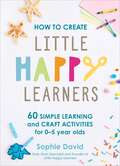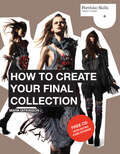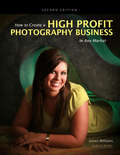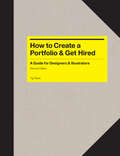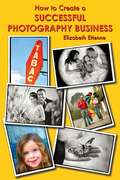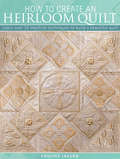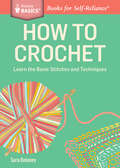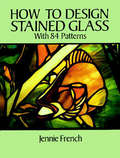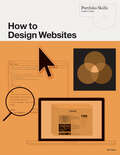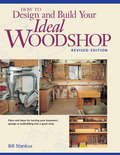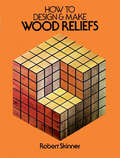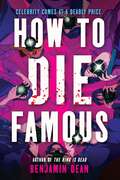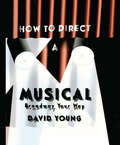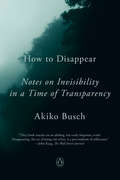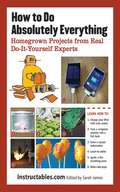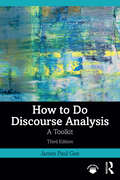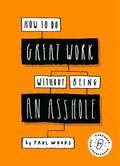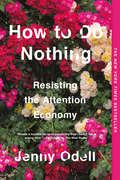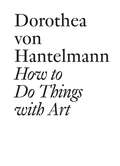- Table View
- List View
How to Create Little Happy Learners: 60 simple learning and craft activities for 0-5 year olds
by Sophie DavidHow to Create Little Happy Learners presents an inspiring selection of learning and craft activities designed to promote a love of learning. Written by Sophie David, a former early years teacher and adviser who is now a stay-at-home mum with 3 children under 5, she is now channelling her knowledge and creativity to show-case the craft ideas she was using to keep her children entertained. Here, she offers over 60 fun-packed activities for children, all highlighting different skills (fine motor, phonics, maths, creativity, communication and independence). Split into topics ranging from animals to transport, Sophie not only offers crafting activities that involve children and can be used time and time again utilising everyday items, she also adapts each activity for different age groups (from 0-5 years) so you can reuse the book as your child grows.Some activities include:- Searching for animal fossils (phonics and creativity)- Bug Count (problem solving and maths)- Emotion stones (communication)- Creating sensory bags (baby play and motor skills)This book offers a bank of great activities to not only inspire a love of learning in your children but to make that journey a fun, craft filled one.
How to Create Your Final Collection: A Fashion Student's Handbook (Portfolio Ser.)
by Mark AtkinsonDesigning a final degree collection is a fashion student’s first chance to approach the reality of the industry. This handbook provides a step-by-step guide to creating this collection, with each chapter exploring a different stage of the project: from understanding the brief and identifying the market to research, development and sampling, through to garment design, range planning, and styling and presentation.Richly illustrated with 350 colour photographs, the book builds on the skills learnt by students during their degree course and throughout the creation of their capsule collection. The accompanying case studies, featuring inspirational work by fashion students from 18 top fashion schools around the world, illustrate every stage of the process and showcase new talent.The book will be accompanied by a CD containing 15 additional student case studies.
How to Create Your Final Collection: A Fashion Student's Handbook (Portfolio Skills)
by Mark AtkinsonDesigning a final degree collection is a fashion student’s first chance to approach the reality of the industry. This handbook provides a step-by-step guide to creating this collection, with each chapter exploring a different stage of the project: from understanding the brief and identifying the market to research, development and sampling, through to garment design, range planning, and styling and presentation.Richly illustrated with 350 colour photographs, the book builds on the skills learnt by students during their degree course and throughout the creation of their capsule collection. The accompanying case studies, featuring inspirational work by fashion students from 18 top fashion schools around the world, illustrate every stage of the process and showcase new talent.The book will be accompanied by a CD containing 15 additional student case studies.
How to Create a High Profit Photography Business in Any Market
by James WilliamsRecognizing that technical ability and studio space are only the initial components of a portrait photography business, this guide to building a thriving portrait studio focuses on successful customer service, networking, diversification, and business management strategies. From setting long- and short-term goals for a business to creating an elegant studio atmosphere that impresses clients (while respecting the budget), this handbook breaks down each minute consideration in the growth of a successful business. Smart managerial decisions regarding portrait-pricing strategies, employee training, telephone skills, positive relationships with suppliers, and responsible delegation of duties are complemented by practical advice on networking within a community, creating demand for high-quality portraiture, and diversifying clientele by catering to the unique needs of each client subset.
How to Create a Portfolio & Get Hired Second Edition: A Guide for Graphic Designers, Illustrators
by Fig TaylorThis book shows those embarking on an illustration or graphic design career how best to put together an effective, professional portfolio. It discusses what to include and how to organize and display the work, and also advises on presentation techniques and self-promotion. Both print and digital portfolios are covered. Deciding who to approach for work is of key importance whether you are looking for a full-time position or freelance work, and the book maps out the creative marketplace, examining the main areas of work and describing the types of position available in each, and how the commissioning process works. Tips are included from commissioners and practitioners working in magazine and book publishing, design, advertising, TV/film and beyond, as well as agents and educators. The book also features a listings section detailing online resources and publications to aid research, suppliers, specialist libraries, industry-related trade fairs and professional organizations.First edition ISBN: 9781856696722
How to Create a Portfolio and Get Hired Second Edition
by Fig TaylorThis book shows those embarking on an illustration or graphic design career how best to put together an effective, professional portfolio. It discusses what to include and how to organize and display the work, and also advises on presentation techniques and self-promotion. Both print and digital portfolios are covered. Deciding who to approach for work is of key importance whether you are looking for a full-time position or freelance work, and the book maps out the creative marketplace, examining the main areas of work and describing the types of position available in each, and how the commissioning process works. Tips are included from commissioners and practitioners working in magazine and book publishing, design, advertising, TV/film and beyond, as well as agents and educators. The book also features a listings section detailing online resources and publications to aid research, suppliers, specialist libraries, industry-related trade fairs and professional organizations.First edition ISBN: 9781856696722
How to Create a Successful Photography Business
by Elizabeth EtienneHow to Create a Successful Photography Business is a comprehensive how-to manual, jam-packed with the secrets to creating a photography business that can generate a stable income. With the most up-to-date, comprehensive information on the photography business, the book addresses the taboo conflict of artist vs. moneymaker and attempts to demystify fantasy from reality.Etienne encourages photographers to define the subjects they would like to shoot and research the income earning potential of these subjects. Chapters are presented in chronological order, starting with ?ling the legal documents to establishing a real photo business and extending to client relations, marketing, prepping, and shooting. The book also includes templates for legal documents and an extensive reference section on photo-related products, support groups, and services.
How to Create an Heirloom Quilt: Learn Over 35 Machine Techniques to Build a Beautiful Quilt
by Pauline InesonLearn how to create the stunning heirloom quilt that has been awarded around the world, while discovering more than thirty sewing machine techniques in the process. Nine beautiful panels form each section of the quilt, and at the end of each chapter you can hone your skills by creating a variety of projects, from cushions and bags to Christmas stockings and album covers. Whether you want to learn new techniques or brush up on your quilting skills, the comprehensive step-by-step technique advice and invaluable tips and tricks will help you along the way. Stylish photography and easy-to-follow layouts complete the package, making this book essential for anyone who wants sophisticated results from straightforward machine techniques.
How to Crochet: Learn the Basic Stitches and Techniques. A Storey BASICS® Title (Storey Basics)
by Sara DelaneyGet hooked on crochet and bring handcrafted charm to your home and wardrobe. Sara Delaney provides easy-to-follow illustrated instructions for joining, fastening off, selecting color schemes, and much more. Learn how to read crochet patterns and work a basic chain with single or double stitches. You’ll quickly be on your way to crafting your own pretty potholders and delicate scarves.
How to Decorate
by Shannon Fricke Prue RuscoeIf you dream of decorating (or redecorating) your home but have no idea where to begin, this decorating workshop-in-a-book decodes an interior designer's thought process on creating a stylish home with vision and flow.The secret to those gorgeous interiors in the magazines lies not in the things that fill the rooms, but in the "decorating story" or point of view that the designer has applied to the space. With How to Decorate, learn how to create your own design concept and implement it with color, furniture, fabrics, lighting, accessorizing, and styling. This book also helps solve a decorator's biggest challenges, from working around a home's existing architecture and organizing a space, to mixing patterns and editing collections. Best of all, 150 color photographs and charming watercolor illustrations--and even a bookplate for personalizing this guide--provide inspiration that makes this book as useful as it is beautiful.Among the insider tips is information on:-Finding a dedicated space where you can organize paint samples, fabric swatches, and magazine clippings-Choosing a sofa wisely-Determining appropriate wall finishes and textures-Identifying what fabrics are right for you-Styling your decor to reinvigorate your space-Plus, the best suppliers for rugs, linens, accessories, and more"Interior design should be about telling a personal story, and Shannon Fricke has nailed it on the head with How to Decorate. Her genius tips ring true for novice and professional decorators alike, and her decorating workshop-in-a-book organization helps simplify what can be a very intimidating process. This book will empower and motivate you to tell your personal story through your home decor. Bravo, Shannon!" --Jenny Komenda, designer and founder of Little Green Notebook"How to Decorate throws out stuffy notions of doing things the 'right' way and instead invites us to imagine our homes as playgrounds for authentic self-expression. Fricke promotes the idea of decorating at its best, as a means of creating surroundings that reflect who we really are and what we love . . . while having a blast in the process!" --Camille Styles, event designer and editor of CamilleStyles.com"Shannon strikes the elusive balance between visual inspiration and practicable action. This is a book you'll both display and put to constant use." --Anne Sage, blogger and founder of The City Sage
How to Design Stained Glass
by Jennie French"This book is an introduction to designing for stained glass. It is directed to those people who have mastered the basic skills of glassworking but who have little or no formal art training. It is the book that I wanted when I first started out." - Jennie FrenchIn this invaluable guide, stained glass artist Jennie French teaches you step by step how to design stained glass projects of your own - even if you have had no previous training in design. For inspiration, study, and practice, she incorporates eighty-four carefully selected stained glass projects into the text, ranging from a powerful portrait of an owl in flight to a touching portrayal of St. Francis of Assisi. Also included are designs for flowers, leaves, animals, birds, landscapes, and architectural studies. As you follow Ms. French's program, you'll learn the basic principles and techniques of design. Among the key topics covered: design sources, how to approach both abstract and representational design, enlarging and reworking designs, and how to design flat as well as three-dimensional projects. A new final chapter covers techniques for developing drawing skills, adapting existing designs to your own projects, and the growing use of computer technology in the design and production of stained glass. Designed to encourage a professional and productive attitude toward designing stained glass, this inspiring guide will enable stained glass enthusiasts to move quickly and comfortably into making unique and attractive designs of their own.
How to Design Websites
by Alan PipesThere are books on the nuts and bolts of web design and there are books about website aesthetics, showcasing examples of good design. How to Design Websites contains the essentials of both, addressing the skillsets required to produce websites that are functional and elegant – but from a graphic designer’s perspective. It demonstrates that you can design a working website in minutes without the need for expensive programs. Chapters include Code, Layout, Text and Typography, and Images and Colour Schemes. Useful ‘tips and tricks’ panels are included, as well as step-by-step projects ––such as how to produce a portfolio site – that will be of interest to design students and to graduates of all disciplines. Inspirational ‘Trailblazer’ case studies showcase the best of contemporary designers and their work. Blogs, Facebook, Flickr and HTML5, and new ways of using the web, such as mobile phones and netbooks, are also discussed.
How to Design Websites (Portfolio Skills)
by Alan PipesThere are books on the nuts and bolts of web design and there are books about website aesthetics, showcasing examples of good design. How to Design Websites contains the essentials of both, addressing the skillsets required to produce websites that are functional and elegant – but from a graphic designer’s perspective. It demonstrates that you can design a working website in minutes without the need for expensive programs. Chapters include Code, Layout, Text and Typography, and Images and Colour Schemes. Useful ‘tips and tricks’ panels are included, as well as step-by-step projects ––such as how to produce a portfolio site – that will be of interest to design students and to graduates of all disciplines. Inspirational ‘Trailblazer’ case studies showcase the best of contemporary designers and their work. Blogs, Facebook, Flickr and HTML5, and new ways of using the web, such as mobile phones and netbooks, are also discussed.
How to Design and Build Your Ideal Woodshop
by Bill StankusTurn your vision of the perfect woodshop into reality!Picture your ideal woodshop: tools neatly stored within the reach, plenty of space for lumber and materials, ample ventilation, lighting and electrical outlets. Everything you need, exactly the way you want it.Whether your woodshop is in the garage, basement, outbuilding, attic or even a closet, you can make the most of your space and bring your ideal woodshop to life. The invaluable advice, layouts and planning tips inside show you how.From space management and tool setup to noise reduction and dust control, Bill Stankus covers every subject in detail. He takes a logical approach to woodshop organization, showing you dozens of ways to achieve optimum efficiency for less time and money. In this completely revised edition, you'll learn how to: • Plan your ideal woodshop--everything from lumber storage and ventilation to dust collection and lighting • Avoid potential mistakes and injuries with safety-first checklists • Make your woodshop environment comfortable and cozy • Maximize space with ideas for building mobile storage units and workstations • Create useful storage space and the perfect workbench • Customize your woodshop, while considering layout and budget issuesSeven examples of actual "ideal" workshops, with insights and ideas from the woodworkers who designed them, help illustrate every guideline and tip.You can begin transforming the space you've got into the shop you dream about--quickly, practically and effectively.
How to Design and Make Wood Reliefs
by Robert Skinner11 projects detailed with measurements, photographs, specifications on tools and materials needed, information on framing, finishing, design concepts, more. Free-form reliefs, geometric illusions, and wooden puzzles, constructed with the help of 24 templates.
How to Die Famous
by Benjamin DeanFor fans of Little White Lies and Two Can Keep a Secret comes an addictive thriller about a budding teen celebrity secretly investigating his brother's suspicious death while navigating the highs and lows of fame. Rising star Abel Miller has just landed a role in one of the hottest reboots on the Omni Channel, Sunset High. It looks like he&’ll be yet another budding celebrity plucked from obscurity, but he has a secret: his brother, Adam, a mere production associate, died during the filming of the last attempt at Sunset High, and no one knows how... or why. Abel is going to find out. But when he meets the other stars of the show— Lucky, Ryan, and Ella, along with creator Lake Carter— he realizes there&’s even more darkness beneath the shimmer of fame. They all have their own secrets to hide, and one of them is willing to kill to keep it that way.
How to Direct a Musical
by David YoungHow to Direct a Musical is a lively and practical guide to the seemingly overwhelming task of directing a musical. David Young brings to this handbook his extensive experience as a director of over 100 productions and more than 250 workshops in the US, China, Senegal and Brazil. Young takes a pragmatic, do-it-yourself approach, guiding the reader from planning to casting, rehearsal to opening night. Topics covered include script analysis, collaboration with designers, musical directors, choreographers and crew, eliminating lengthy pauses between scenes, dress rehearsals and curtain calls.
How to Disappear: Notes on Invisibility in a Time of Transparency
by Akiko BuschVivid, surprising, and utterly timely, Akiko Busch's HOW TO DISAPPEAR explores the idea of invisibility in nature, art, and science, in search of a more joyful and peaceful way of living in today's increasingly surveilled and publicity-obsessed worldIn our increasingly networked and image-saturated lives, the notion of disappearing has never been both more enchanting and yet fanciful. Today, we are relentlessly encouraged, even conditioned, to reveal, share, and self-promote. The pressure to be public comes not just from our peers, but vast and pervasive technology companies, which want to profit from patterns in our behavior. A lifelong student and observer of the natural world, Busch sets out to explore her own uneasiness with this arrangement, and what she senses is a widespread desire for a less scrutinized way of life--for invisibility. Writing in rich painterly detail about her own life, her family, and some of the world's most exotic and remote places--from the Cayman Islands to Iceland--she savors the pleasures of being unseen. Discovering and dramatizing a wonderful range of ways of disappearing, from virtual reality goggles that trick the wearer into believing her body has disappeared and to the way Virginia Woolf's fictional Mrs. Dalloway feels a flickering of personhood as an older woman, Busch deliberates on subjects new and old with equal sensitivity and incisiveness.A unique and exhilarating accomplishment, HOW TO DISAPPEAR is a shimmering collage of poetry, cinema, memoir, myth, and much more, which overturns the dangerous modern assumption that somehow fame and visibility equate to success and happiness. Busch presents a field guide to invisibility, reacquainting us with the merits of the inconspicuousness, and finds genuine alternatives to the typical life of perpetual exposure. Accessing timeless truths in order to speak to our most urgent contemporary problems, she inspires us to develop a deeper appreciation for personal privacy in a vast and invasive world.
How to Do Absolutely Everything: Homegrown Projects from Real Do-It-Yourself Experts
by Instructables. Com Sarah JamesContinuing the Instructables series with Skyhorse Publishing, a mammoth collection of projects has been selected and curated for this special best-of volume of Instructables. The guides in this book cover the entire spectrum of possibilities that the popular website has to offer, showcasing how online communities can foster and nurture creativity.From outdoor agricultural projects to finding new uses for traditional household objects, the beauty of Instructables lies in their ingenuity and their ability to find new ways of looking at the same thing. How to Do Absolutely Everything has that in spades; the possibilities are limitless, thanks to not only the selection of projects available here, but also the new ideas you'll build on after reading this book. Full-color photographs illustrate each project in intricate detail, providing images of both the individual steps of the process and the end product.
How to Do Discourse Analysis: A Toolkit
by James Paul GeeHow to Do Discourse Analysis provides a comprehensive toolkit for conducting discourse analysis, offering 26 practical tools to examine how language is used to construct meaning, enact identities, and shape social realities. Written by renowned linguist James Paul Gee, it introduces key concepts like situated meanings, social languages, and Discourses, showing how language both reflects and creates social contexts.This essential textbook takes readers through a step-by-step process of analyzing texts and talk, from examining grammar and vocabulary to uncovering underlying ideologies and power dynamics. It covers a wide range of discourse types, from everyday conversations to political speeches and social media posts. Gee draws on diverse examples from education, politics, media, and popular culture to illustrate the tools in action.While grounded in linguistic theory, the book emphasizes hands-on application. Each tool is accompanied by sample analyses and practice exercises. This new edition incorporates recent developments in digital communication and updates examples for contemporary relevance, making it an ideal resource for advanced undergraduate and postgraduate students working in the areas of applied linguistics, education, psychology, anthropology, and communication.
How to Do Great Work Without Being an Asshole: (guides For Creative Industries)
by Paul Woods'How to Do Great Work Without Being an Asshole, a new book by designer Paul Woods, is a practical, illustrated guide that does exactly what the title suggests: It shows you how to be both creative and act like a grown-up at work.' - Fast CompanyIt's long been an accepted, almost celebrated, fact of the creative industries that long hours, chaotic workflows and egotistical colleagues are just the price you pay to produce great work. In fact, this toxic culture is the enemy of creativity, and with greater accountability and transparency in the industry - and more choice for young talent - than ever before, this unsustainable way of doing business is a ticking time bomb.This is a straight-talking, fun read for all creatives: Director or junior, at an agency or client-side, working in design, advertising, publishing, fashion or film.Packed with anecdotes, self-analysis flowcharts (are YOU the asshole?!), humorous graphics, and helpful exercises and action plans for better working practices.Simple strategies can easily be implemented to create a happier, more productive team and - importantly - BETTER WORK!Read this guide to develop the ultimate creative process and bring your productivity and teamwork to a new level.How to Do Great Work Without Being an Asshole addresses hot topics like:Building a better office cultureDealing with egosMeeting etiquetteBest practices for pitching and scopingMaking the most of creative briefingsHow to give constructive, clear feedbackGiving better presentations How to approach workloads and long hoursGuidelines for good client relationshipsHiring and being hiredFiring and being firedAnd much more!
How to Do Great Work Without Being an Asshole: (guides For Creative Industries)
by Paul Woods'How to Do Great Work Without Being an Asshole, a new book by designer Paul Woods, is a practical, illustrated guide that does exactly what the title suggests: It shows you how to be both creative and act like a grown-up at work.' - Fast CompanyIt's long been an accepted, almost celebrated, fact of the creative industries that long hours, chaotic workflows and egotistical colleagues are just the price you pay to produce great work. In fact, this toxic culture is the enemy of creativity, and with greater accountability and transparency in the industry - and more choice for young talent - than ever before, this unsustainable way of doing business is a ticking time bomb.This is a straight-talking, fun read for all creatives: Director or junior, at an agency or client-side, working in design, advertising, publishing, fashion or film.Packed with anecdotes, self-analysis flowcharts (are YOU the asshole?!), humorous graphics, and helpful exercises and action plans for better working practices.Simple strategies can easily be implemented to create a happier, more productive team and - importantly - BETTER WORK!Read this guide to develop the ultimate creative process and bring your productivity and teamwork to a new level.How to Do Great Work Without Being an Asshole addresses hot topics like:Building a better office cultureDealing with egosMeeting etiquetteBest practices for pitching and scopingMaking the most of creative briefingsHow to give constructive, clear feedbackGiving better presentations How to approach workloads and long hoursGuidelines for good client relationshipsHiring and being hiredFiring and being firedAnd much more!
How to Do Nothing: Resisting the Attention Economy
by Jenny OdellA galvanizing critique of the forces vying for our attention—and our personal information—that redefines what we think of as productivity, reconnects us with the environment, and reveals all that we’ve been too distracted to see about ourselves and our world <P><P>Nothing is harder to do these days than nothing. But in a world where our value is determined by our 24/7 data productivity . . . doing nothing may be our most important form of resistance. So argues artist and critic Jenny Odell in this field guide to doing nothing (at least as capitalism defines it). <P><P>Odell sees our attention as the most precious—and overdrawn—resource we have. Once we can start paying a new kind of attention, she writes, we can undertake bolder forms of political action, reimagine humankind’s role in the environment, and arrive at more meaningful understandings of happiness and progress. <P><P>Far from the simple anti-technology screed, or the back-to-nature meditation we read so often, How to do Nothing is an action plan for thinking outside of capitalist narratives of efficiency and techno-determinism. Provocative, timely, and utterly persuasive, this book is a four-course meal in the age of Soylent. <P><P><b>A New York Times Bestseller</b>
How to Do Things with Art
by Dorothea Von HantelmannPart of JRP|Ringer's innovative Documents series, published with Les Presses du Réel and dedicated to critical writings, this publication comprises a unique collection of interviews by Hans Ulrich Obrist mapping the development of the curatorial field--from early independent curators in the 1960s and 70s and the experimental institutional programs developed in Europe and the U.S. through the inception of Documenta and the various biennales and fairs--with pioneering curators Anne D'Harnoncourt, Werner Hoffman, Jean Leering, Franz Meyer, Seth Siegelaub, Walter Zanini, Johannes Cladders, Lucy Lippard, Walter Hopps, Pontus Hulten and Harald Szeemann. Speaking of Szeemann on the occasion of this legendary curator's death in 2005, critic Aaron Schuster summed up, "the image we have of the curator today: the curator-as-artist, a roaming, freelance designer of exhibitions, or in his own witty formulation, a 'spiritual guest worker'... If artists since Marcel Duchamp have affirmed selection and arrangement as legitimate artistic strategies, was it not simply a matter of time before curatorial practice--itself defined by selection and arrangement--would come to be seen as an art that operates on the field of art itself?"
How to Do Things with Art: The Meaning of Art's Performativity
by Dorothea Von HantelmannArt has never been as culturally and economically prominent as it is today. How can artists themselves shape the social relevance and impact of their work? <P><P>In How to Do Things with Art, German art historian Dorothea von Hantelmann uses four case study artists--Daniel Buren, James Coleman, Jeff Koons and Tino Sehgal--to examine how an artwork acts upon and within social conventions, particularly through the performing of exhibitions. The book's title is a play on J.L. Austin's seminal text, How to Do Things with Words, which describes language's reality-producing properties and demonstrates that in saying there is always a doing--a linguistic counterpart to the dynamics envisioned by Von Hantelmann for art, in which showing is a kind of doing.
